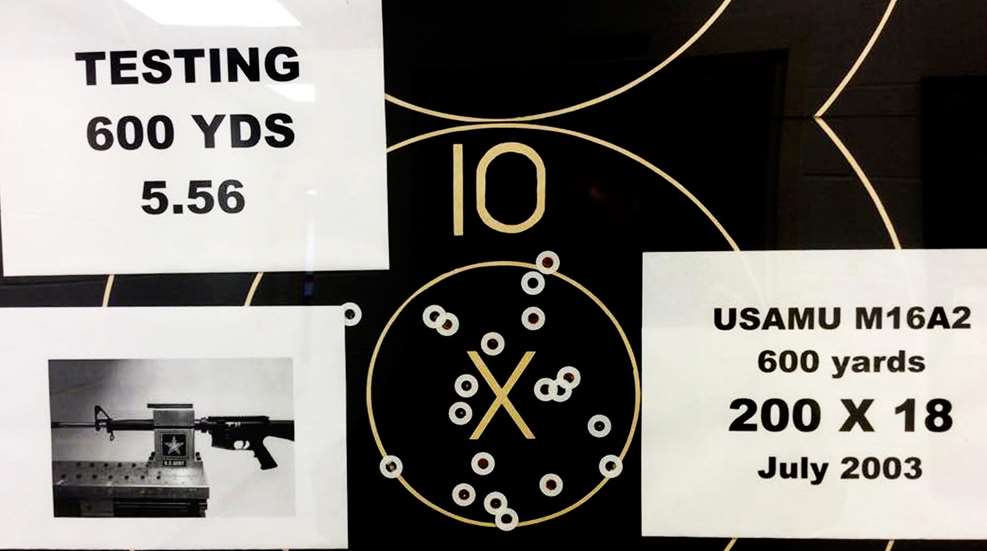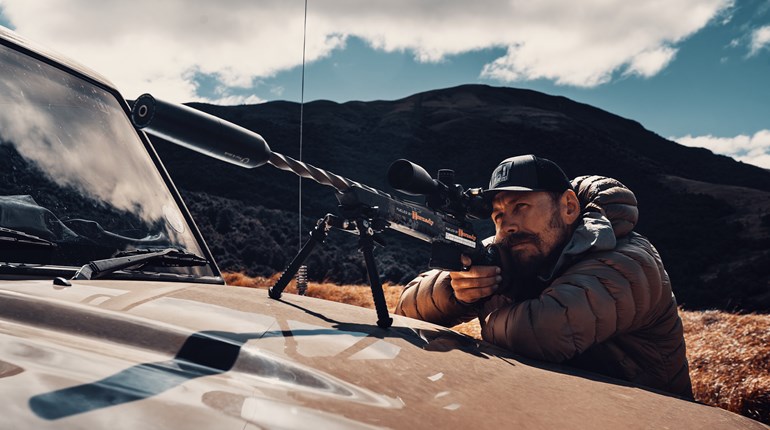
WARNING: All technical data in this publication, especially for handloading, reflect the limited experience of individuals using specific tools, products, equipment and components under specific conditions and circumstances not necessarily reported in the article and over which the National Rifle Association (NRA) has no control. The data has not otherwise been tested or verified by the NRA. The NRA, its agents, officers and employees accept no responsibility for the results obtained by persons using such data and disclaim all liability for any consequential injuries or damages.
Today, we’ll explore basic aspects of testing with telescopic sights—i.e., optics. In Part 1 and Part 2 we detailed proper benchrest shooting technique, and may be helpful to read if you are just catching up.
One aspect which helps complete the previous two articles relates to making rifles with rounded forearms more stable on the bench.
Benchrest Adapters for Non-Benchrest Rifles
As was mentioned previously, dedicated benchrest rifle competitors use stocks with flat-bottomed forends which greatly increase their stability on the rest. High Power, Service and Long-Range rifles typically have round forends, making them more difficult to shoot super-accurately from the bench.
This is due to a tendency to roll from side to side on the bags during aiming or recoil, and is especially prevalent with AR15’s, due to their pistol grip’s being so far below the bottom line of the forend. This acts almost as a lever, and makes these rifles more sensitive to even slight technique flaws using the firing hand.
Various firms make benchrest adaptors that fit a match rifle’s accessory rail or otherwise attach to AR15s. These are nothing more than flat plates of about 2.5 to 3.0-inches wide. They can be adjusted fore and aft to maximize stability on the bags, and they can be a great help. In addition, stock toe adapters are also available, especially for the AR15, which provide a flat, wider surface for greater stability.
Optical Sight Testing Correct Target Size and Magnification
Suit your target to the optics you are using. That is, if you are shooting a 4x hunting scope with medium/heavy crosshairs, then aiming at a 1-inch paster at 100 yards will necessarily introduce some inaccuracy.
Typically, these crosshairs will cover the dot completely, and may even be significantly larger than the dot. If one can’t aim reliably at a fine point—i.e., moving 1/2-inch in any direction still allows covering the dot—then the problem of introducing spread into your groups becomes obvious.
Pick a target size that works well for your magnification, reticle and distance. For scopes of 9-12X, this author has found a 2-inch solid black square on a white or tan background works well at 100 yards.
He is able to quarter the square evenly with the crosshairs. He has no difficulty shooting excellent groups with this setup—0.3 to 0.5 MOA consistently with various .308’s, etc., depending on the accuracy of the rifle.
Depending on eyesight and scope, some may prefer an orange target instead of black. If the scope allows it, some prefer to align the crosshairs with the vertical and horizontal edges of one corner.
It's wise to try both methods. A very fine shooter of the author's acquaintance prefers this technique. Yet, in periodic tests over 30 plus years, centering the square has consistently worked best for this writer.
Jumping up to approximately 20-24x power, the typical 100-yard “benchrest” target has worked well. This consists of a heavy-lined, 1-inch black square with a white center, plus thin scoring rings below it. These often come with six aiming marks on a single sheet of paper. This reduces the time and supplies needed for testing. There are also scaled-up versions for 200 and 300 yards.
The extra magnification vs. a 10-12x scope means the shooter can resolve much smaller parts of the target. Depending on one’s eyesight, crosshairs, bench technique and general preferences, one can hold on the white center of the square, or on one corner as described above. Or, one may prefer the white center of the “bullseye” scoring rings below the square, etc.
Whatever method one chooses, it is best to have the rifle zeroed approximately 1.0- to 1.5-inch away from the point of aim. A low point of impact is preferred—shooting high can put shots into the black square, where they can be hard to see.
Shooting low offers the benefit of seeing and “calling” each shot as it is fired. Zeroing away from your point of aim avoids grouping bullets on the aiming point, making it ragged, indistinct or non-existent.
Adjusting Crosshair Focus
Along with basic set-up of one’s equipment, it is important to focus one’s scope/crosshairs for one’s eyesight. This is also the time to adjust the scope’s parallax, which eliminates aiming error at one's exact target distance. These two topics can cause much confusion for the beginning shooter.
To focus the crosshairs for one’s eyes, quickly aim the scope at a blank, featureless surface—a wall, the sky, etc. See if the crosshairs are sharply focused and heavily black. It’s very important to do this within only a few seconds of starting to view through the scope.
The eye naturally tends to accommodate and adjust its focus to make the crosshairs sharp. The goal is to see the crosshairs in focus instantly, without having to adjust the eye.
It’s best to check this several times, to start. After moving the scope away from the eye, look at a distant object before returning the scope for another quick look. If the crosshairs are verified to be in-focus, no further action is required.
If they are not, the focus adjustment is on the *rear* lens—the ocular lens. Many scopes secure the eyepiece adjustment via a lock-ring jammed against it. This ring must be loosened to begin adjustments.
The easy method is to screw the eyepiece assembly out (to the rear, or counter-clockwise), away from the ring. Move the lock ring forward for clearance, and begin turning the eyepiece in 1/2 turns in one direction. Make frequent, quick checks on the crosshair focus. If they get fuzzier, reverse directions and repeat.
Once the crosshairs are in sharp focus instantly when viewing against a blank surface, secure the lock ring. Scopes with improved ergonomics may have a readily adjustable eyepiece without a lock.
These typically feature a rear adjusting ring that rotates smoothly to set the crosshairs focus. They also often feature a plus/minus scale to help measure and repeat settings. While this simplifies the operation, the principle is the same.
Parallax Correction
Next, we move to parallax, which is the apparent shift of the crosshairs against a fixed aiming point when moving one’s eye around behind the eyepiece. Place the rifle on the rest and settle the crosshairs on an aiming point at one's target distance.
*Without touching the rifle*—put your eye behind the scope. Move your head up, down, left and right within the limits of your ability to see through the scope. If there is no apparent movement of the crosshairs on the target, your scope is parallax-free at that distance. Crosshair movement indicates parallax.
Most standard hunting scopes do not have adjustable parallax. They are set by the factory at a particular distance: usually 100-150 yards for centerfire, and 50-75 yards for quality rimfire scopes.
With these, know that parallax effect is far more dramatic at ranges significantly *shorter* than the distance at which the scope is set, rather than farther away. Moreover, one’s natural tendency to use a consistent head position will help minimize parallax effect.
Target scopes, or scopes with higher magnification, typically have parallax adjustment. Older or less-expensive scopes typically adjust via a ring around the objective lens bell. One will see distances such as “50, 75, 100, 150” etc. marked at intervals around the ring.
Beware! *Many times, these seem to be for decorative purposes only, as they bear no meaningful relation to the actual firing distances!*
One should always verify the parallax ring setting when the scope is parallax-free at one’s chosen distance. More recently, the better manufacturers have begun calibrating the distance on the ring to the actual, correct parallax setting. This certainly makes life easier for the shooter.
Once one has checked a particular scope and knows how it functions, simply dial out the parallax whenever one changes shooting distances, for maximum accuracy. Newer scopes—particularly target or “tactical” models—increasingly feature a side parallax adjustment knob opposite the windage knob. This facilitates making adjustments easily from field or bench positions.
Next up: Accuracy and Chronograph Testing, Part 4.
SSUSA thanks the U.S. Army Marksmanship Unit for allowing the reprint of this article.

































